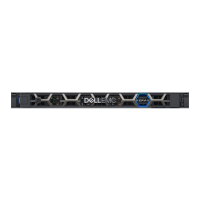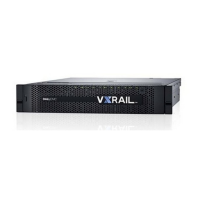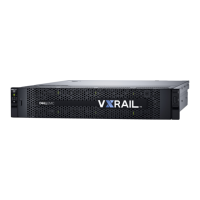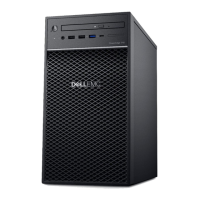39 | Network Planning Guide
© 2018 Dell Inc. or its subsidiaries
VxRail Setup Checklist
✓ VxRail cluster: Decide if you want to plan for additional nodes beyond the initial three (or four)-node cluster. You can have up to 64 nodes in
a VxRail cluster
✓ VxRail ports: Decide how many ports to configure per VxRail node, what port type, and what network speed
✓ Network switch: Ensure your switch supports VxRail requirements, and provides the connectivity option you chose for your VxRail nodes.
Verify cable requirements.
✓ Data Center: Verify the required external applications for VxRail are accessible over the network and correctly configured
✓ Topology: Decide if you will have a single or multiple switch setup for redundancy.
✓ Workstation/laptop: Any operating system with a browser to access the VxRail user interface. The latest versions of Firefox, Chrome, and
Internet Explorer 10+ are all supported.
✓ Out-of-band Management (optional): One available port that supports 1Gb for each VxRail node.
✓ One external management VLAN with IPv6 multicast for traffic from VxRail, vCenter Server, ESXi (recommended is
untagged/native).
✓ One internal management VLAN for auto-discovery and device management. The default is 3939.
✓ One VLAN with IPv4 unicast (starting with VxRail 4.5.0) or IPv4 multicast (prior to Release 4.5.0) for vSAN traffic.
✓ One VLAN for vSphere vMotion.
✓ One or more VLANs for your VM Network(s).
✓ If you are planning to enable Dell-EMC SmartFabric services, one VLAN for the VxRail cluster build network
✓ If you enabling witness traffic seperation, one VLAN for the VxRail witness traffic separation network
✓ Time zone.
✓ Hostname or IP address of the NTP server(s) on your network (recommended).
✓ IP address of the DNS server(s) on your network (required).
✓ Forward and reverse DNS records for VxRail management components
✓ Decide on your VxRail host naming scheme. The naming scheme will be applied to all VxRail management
components
✓ Reserve three or more contiguous IP addresses for ESXi hosts.
✓ Decide if you will use a vCenter Server that is Customer Supplied or new to your VxRail cluster.
✓ VxRail vCenter Server: Reserve two IP addresses for vCenter Server and PSC
✓ Customer Supplied vCenter Server: Determine hostname and IP address for vCenter and PSC , administration user, and
name of vSphere data center. Create a VxRail management user in vCenter. Decide on a unique VxRail cluster name.
(Optional) Create a VxRail non-admin user.
✓ Reserve one IP address for VxRail Manager.
✓ Determine default gateway and subnet mask.
✓ Select passwords for VxRail management components
✓ Reserve three or more contiguous IP addresses and a subnet mask for vSphere vMotion.
✓ Reserve three or more contiguous IP addresses and a subnet mask for vSAN.
✓ To use vRealize Log Insight: Reserve one IP address
✓ To use an existing syslog server: Get the hostname or IP address of your third-party syslog server.
✓ If witness is required, reserve one IP address for the management network and one IP address for the vSAN network
✓ Configure your workstation/laptop to reach the VxRail initial IP address.
✓ Make sure you also know how to configure the laptop to reach the VxRail Manger IP address after configuration.

